Very few trail running shoes have a whole lore around them the way the Speedgoat does. A decade has passed since the arrival of the original Speedgoat trail running shoe, which was christened in honour of the nickname of Hoka athlete Karl Meltzer. It changed the game with its trailblazing construction, sumptuous cushioning and exceptional energy return.
Of the five versions that followed, the progression has mostly been positive. Some versions have fared better than others in both reviews and user experiences. Versions 2, 4 and 5 earned particular praise.
But then you have to consider that there are only so many tweaks and adaptations a brand can make to a much-loved product before you start to change its nature beyond recognition. Or worse, erode the things people love about it. Even those who have followed the evolution of the Speedgoat carefully can find it easy to get lost in what has changed, or changed back, over time.

So in this review, we will of course look at what’s new with version 6, and how that compares with its immediate predecessor, and some of its current competitors. But we also think it’s important to consider the shoe in isolation, on its own merits. Especially for the benefit of anyone who has never tried, or perhaps even heard of, a Speedgoat before and couldn’t care less how it compares with the 2 or the 4.
You can find a dozen review sites out there which assume you’ve tried and worn every single Speedgoat along the way and will understand every intricate reference they drop. LFTO isn’t one of them. What we’re concerned with is just this: how good is it, and is it right for you? So here goes.
Find the women’s version here
Pros
- Excellent cushioning
- Supportive and stable
- Good traction
- Relatively lightweight
- Rockered outsole
- Available in wider fit
Cons
- Not as breathable as some rivals
- Not geared towards ultra distances
- No Gore-Tex/waterproof version (yet)
| Men’s sizes: | 6½-13½ |
| Women’s sizes: | 3½-10½ |
| Versions: | Regular, wide |
| Weight: | 286g (men’s UK size 9) |
| Drop: | 5mm |
| Stack height: | Men’s 40mm heel, 35mm toe |
| Women’s 38mm heel, 33mm toe | |
| Lugs: | 5mm |
What’s new?
In terms of looks, styling and general ethos, the 6 is very similar to its predecessor, the 5. Like all previous Speedgoats, it has been designed for moving fast over mixed and challenging terrain (ie, anything up to marathon distance; for any longer you'll want to consider some ultra trail running shoes with less of an emphasis on speed and more on long-term comfort and energy return).
But the differences from the 5 are actually pretty substantial. Here they are in a nutshell:
– It’s about 40g lighter
– An extra 1mm of heel drop
– A lighter and (say Hoka) more breathable upper
– Updated materials on the midsole and upper
– A redesigned outsole, inspired by the hoof of a goat
– A redesigned tongue with enhanced padding
– A stiffer heel counter for greater stability
– Reconfigured lacing to aid lockdown at the forefoot
– A heel loop has been added (bizarre that there wasn’t one before)
So that’s a fairly root-and-branch redesign, while still aiming to retain the Speedgoat DNA. It’s definitely not just a cosmetic upgrade.
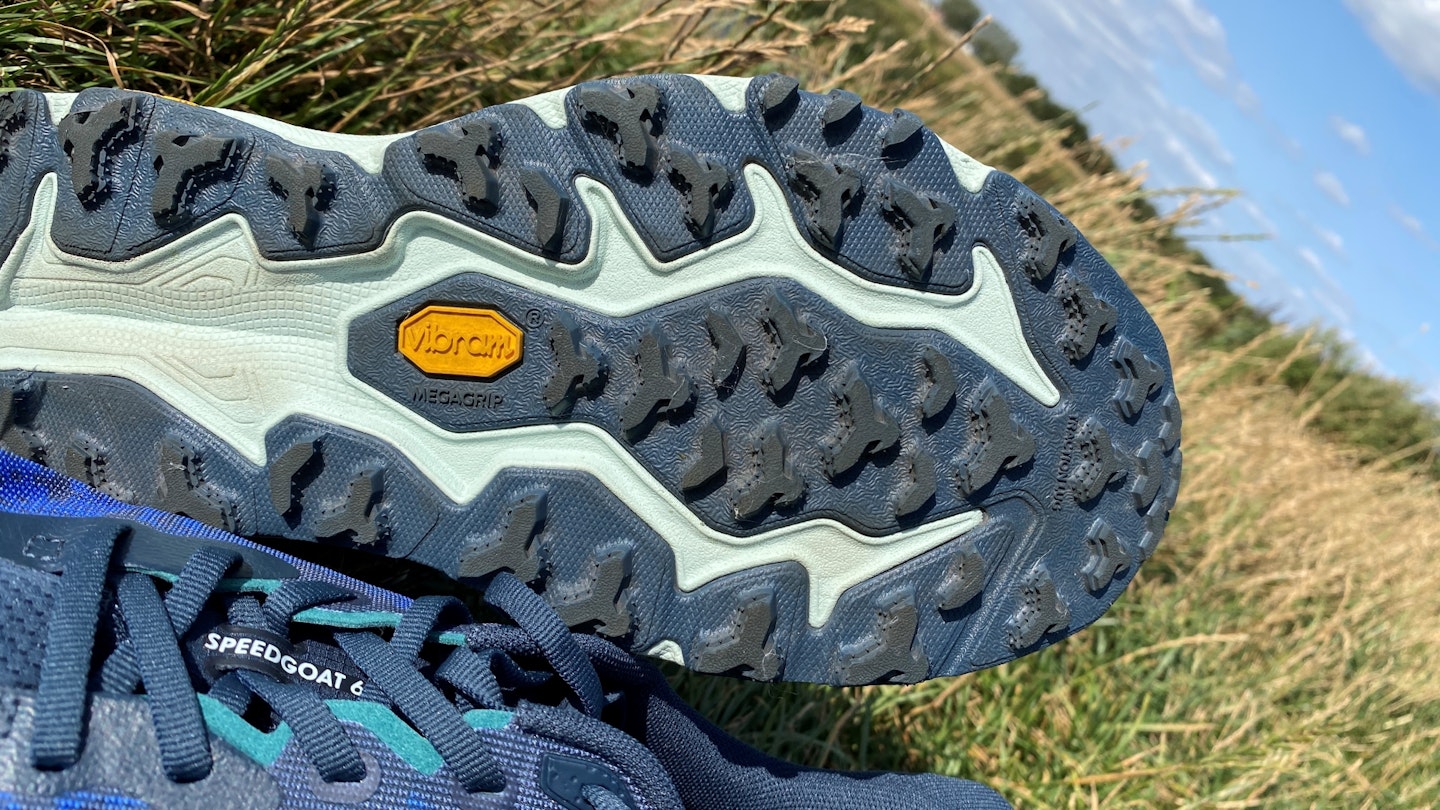
Let’s look in detail at three of those which are probably the most important.
Midsole: The 6 uses a lighter, springier EVA foam compound than its predecessor, with the aim of boosting propulsion with each strike and toe-off.
Outsole: That goat-hoof idea is a rapidly developing trend; we’ve recently seen the same idea on Brooks’ latest trail running shoes, the Cascadia 18 and the Caldera 7. Perhaps it was inevitable that we would see it on a shoe with ‘goat’ in the name. The idea is that the ‘cloven-hoof’ style aids balance and traction. When did you last see a mountain goat trip over or turn an ankle?
Upper: The 6 has a new woven textile upper in place of the jacquard mesh used on the 5. This is designed to improve breathability, although it is also very dense, which may compromise that aim.
So those are the changes. How does it perform on the go?
Performance
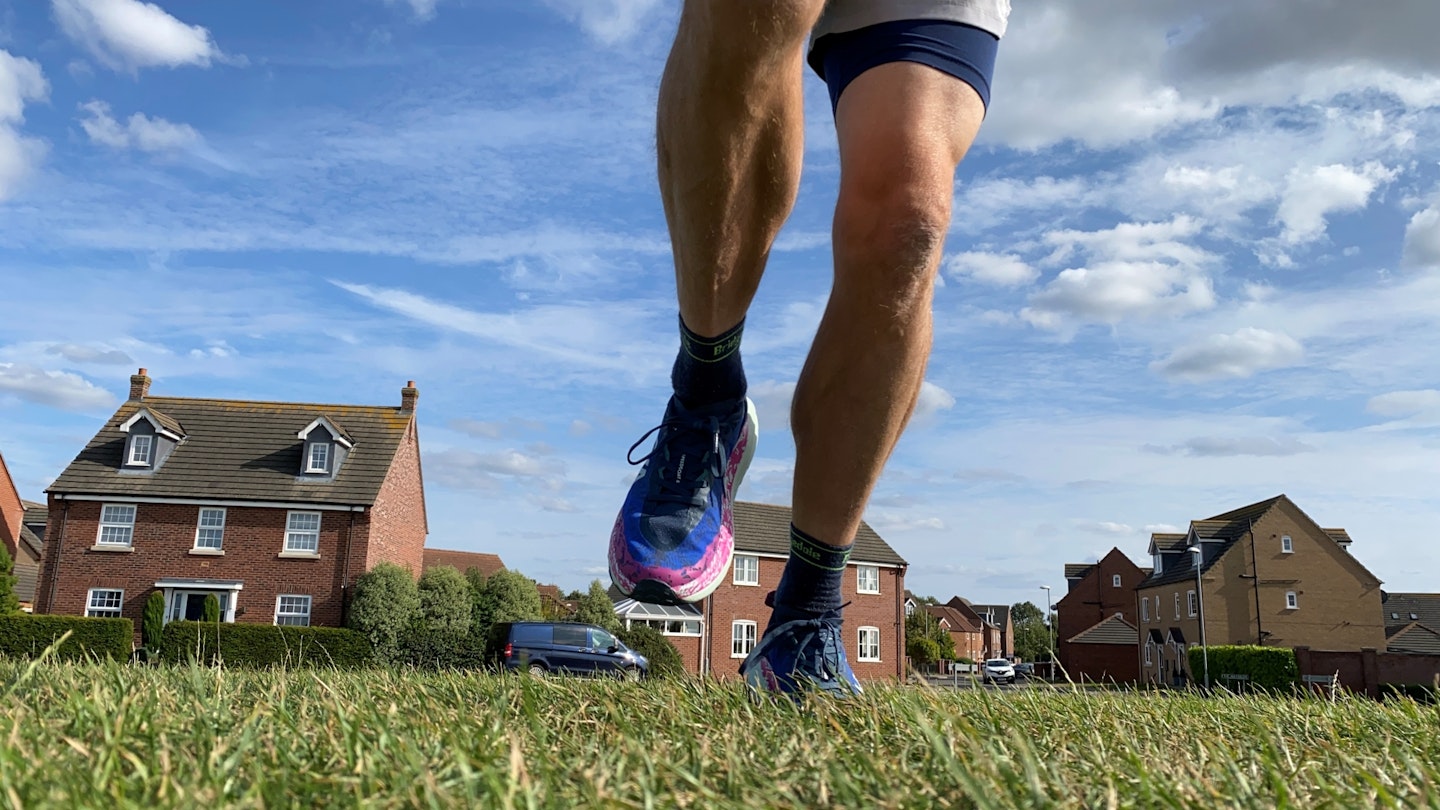
The 6 feels great from the box and doesn’t need a lot of running-in.
I’ve now been running in it for 4 weeks and covered around 200 miles in it, over mixed terrain. There’s no denying it’s a great experience. If you’ve never tried a Speedgoat before, you will likely enjoy the bounce, the cushioning and the confidence they give you over stony ground and slippery mud. Plus they really are just fun to wear.
They seem to be happiest over 10k and half marathon distances, which pretty much squares with what Hoka will tell you. For longer distances where you probably want to move a bit more slowly and stave off fatigue, they struggle a little. My feet definitely feel more tired past the 13-mile mark, where a shoe with a more forgiving insole and greater arch support would adapt better. But over those shorter distances, the energy return is more than adequate.
Their lightweight nature makes them very nimble, although over prolonged ascents the heel starts to feel laggy and heavy – especially if it’s picking up mud.
Comfort
Mostly excellent, especially underfoot (see Fit). One annoying element is the short tongue; OK it’s had a revamp for padding, but it’s still very truncated. You can’t pull it right out, which means it has a tendency to curl or bunch up under the lacing. And if you use the very top eyelets (which I mostly don’t), the lacing will be sitting directly over your skin rather than on top of the tongue. That is very odd. It’s irksome on the go, and a chafing risk in the long run.
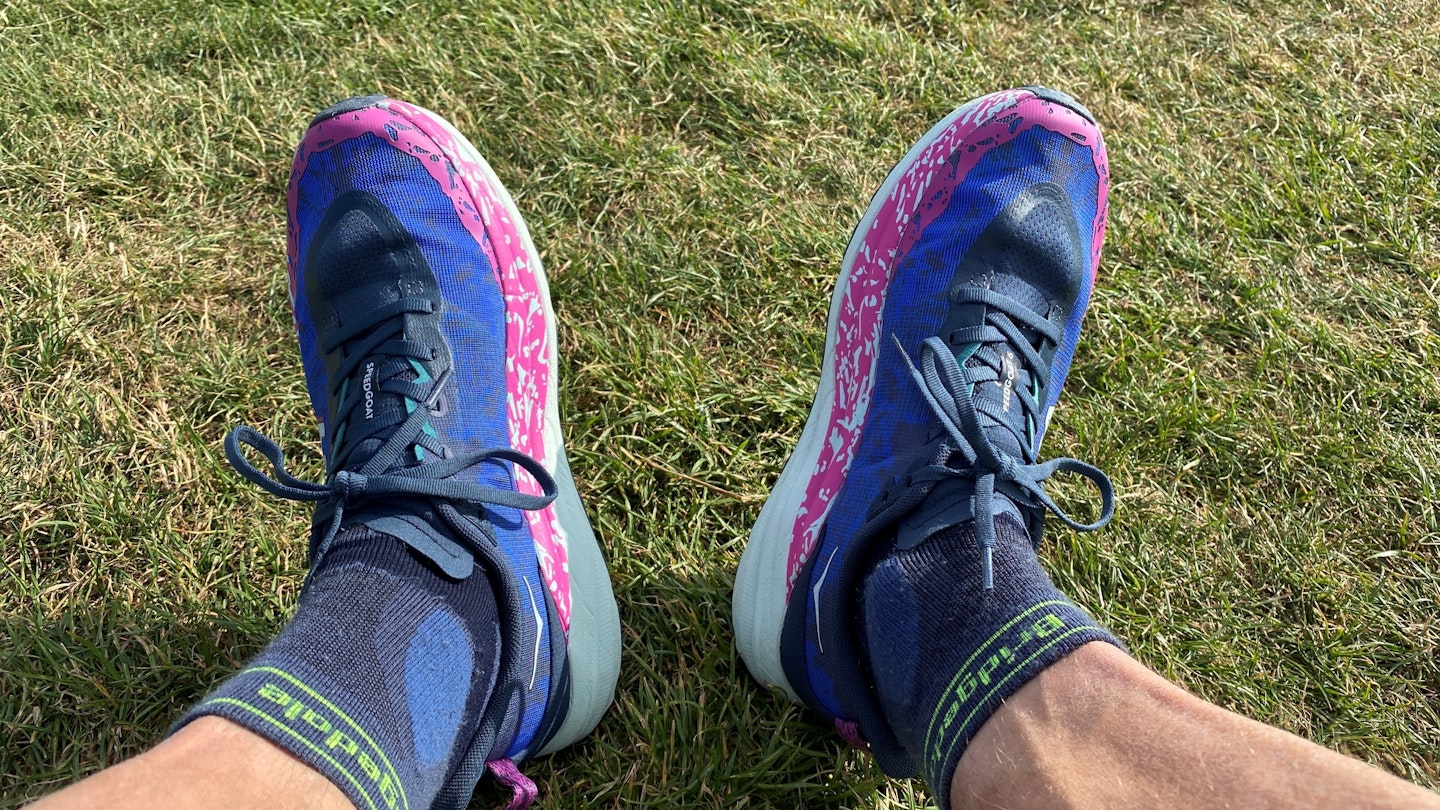
Stability
Absolutely no quibbles about the stability. The combination of close lacing, supportive midsole and carefully moulded heel cup mean the Speedgoat offers a very stable ride, while that goat-hoof outsole makes it very hard to land awkwardly.
Grip and traction
Grip is outstanding. Over the mud and sand of the North York Moors, and the stony trails of the Lake District, the Speedgoat’s Vibram outsole really digs in nicely. I struggle with descents sometimes due to long-standing knee injuries, but the combination of traction and cushioning on the Speedgoat takes a lot of the pain out of tough, steep descents.
You might expect a shoe with such a thick midsole to lack ground-feel, but in fact the Speedgoat 6 does give you a fair sense of what’s under your feet.
Shop this product
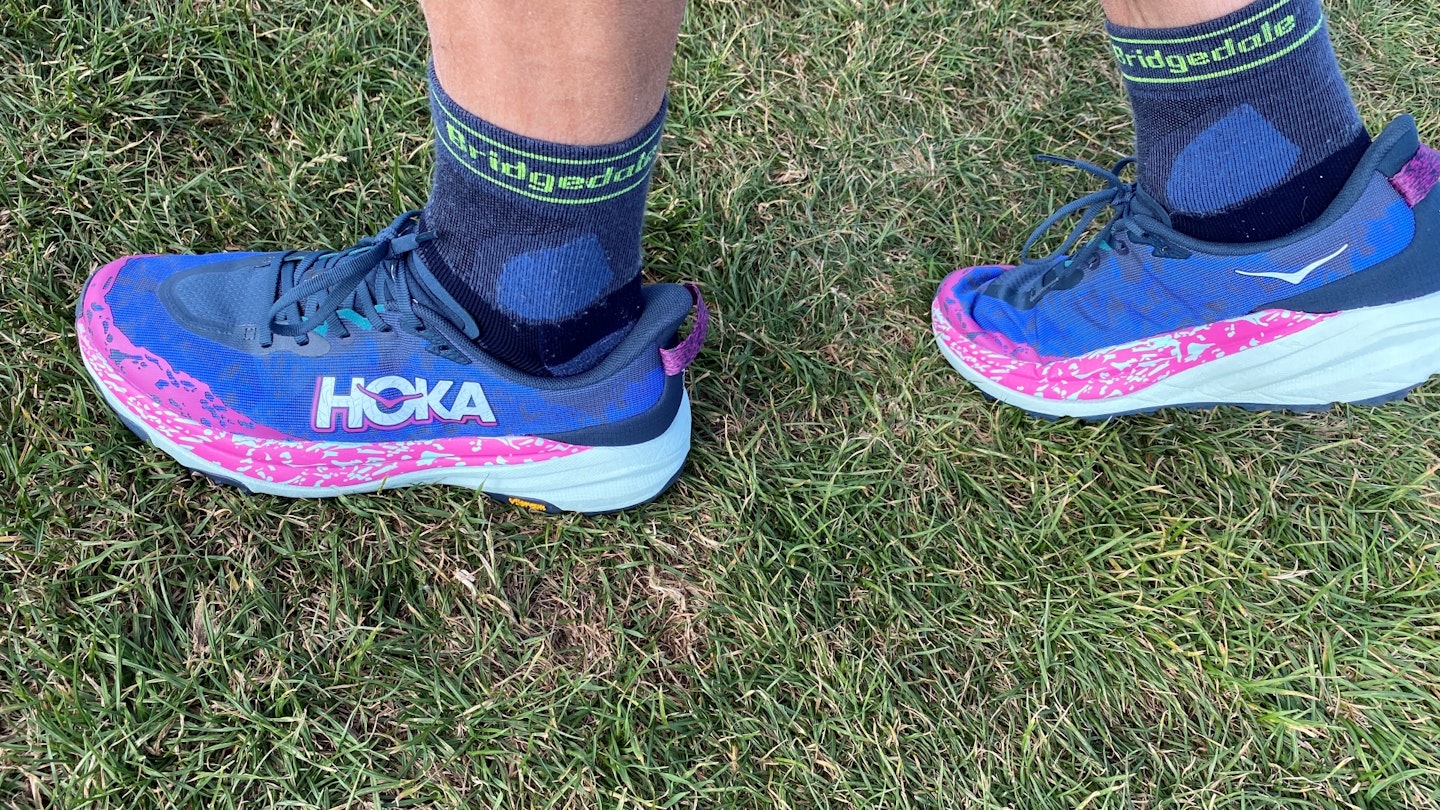
Breathability
I’ve read some criticism of the 6’s breathability in other reviews, but I haven’t experienced any real difficulties, even running in the August heat. In fact, in a straight comparison with the slightly heavier and tougher Brooks Cascadia 18, the airflow definitely felt better in the Speedgoat.
That said, if you do find they lack breathability in the summer heat, you can flip that into a positive: they’re likely to keep your feet that little bit warmer in the fast-approaching months of autumn and winter.
Toughness
Being lightweight and lacking much in the way of bumpers and rands, the Speedgoat is not the toughest running shoe out there – but it’s not meant to be. It’s about speed. So if speed is your priority, you may have to accept that you’re going to feel the bumps and scuffs a bit more keenly in these.
Fit
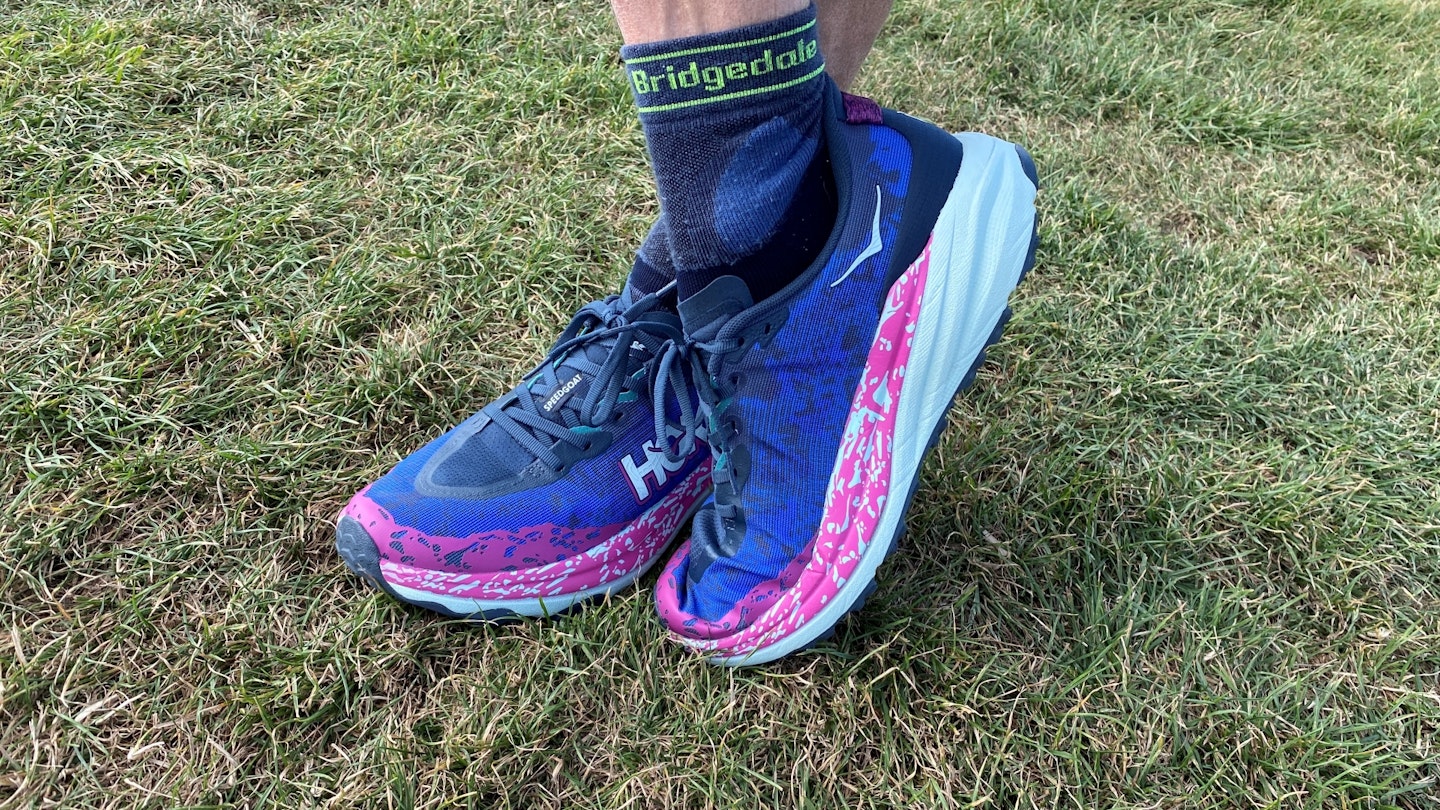
The Speedgoat 6 comes in a regular fit and a wide fit, but in both cases the toe-box area is narrower and lower than some rivals. The upper surfaces of my toes ‘hit the roof’ on toe-off, and I feel occasional rubs on the outside edge of the big toe. If you have wider feet, you might want to consider going up a half-size as well as trying the wide foot option.
It also crimps in a little at the midfoot, and I initially felt a lumpy area on the inside of the arch. This worried me initially but after a few runs, the problem abated as the shoe apparently moulded to my foot-shape.
The heel cradle is supportive and true to fit, and there’s a tough rear peak to shield the achilles area (in fact this is probably the toughest and firmest part of the whole shoe, but it’s neatly designed not to rub).
Sustainability
Disappointingly, Hoka tell us nothing about the sustainability credentials of the Speedgoat 6 on the shoe’s homepage. However, they do have overall drivers in place across all their production processes, including the use of recycled materials, less petrol-based plastic, less timber, less waste, less water and less carbon. You can read more about it here. But it would be nice if we could see how these objectives feed into each specific shoe – especially such a flagship big-seller as the Speedgoat.
Verdict

If you’ve never tried a Speedgoat before, you are likely to love the Speedgoat 6 for all the reasons people love the marque in general: the comfort, the springiness, the nimbleness. Simple as.
I think the Speedgoat’s biggest problem is that it’s just not unique any more. It changed the game, others caught up, and now a vast array of shoes look and perform like the Speedgoat. Just look at the Brooks Caldera 7, Salomon Genesis, Merrell Agility Peak and Nike Zegama 2 for starters.
Shop this product
Meanwhile Hoka themselves have been refining the science of trail running, offering sharper, more precise trail running shoes like the Zinal 2.
That said, it’s unfair to fault the new Speedgoat just for the presence of imitators. Imitation is, of course, the sincerest form of flattery. The Speedgoat can still more than hold its own in the face of all that competition – and it’s still competitively priced against them, too.
It might not be the most precise trail running shoe, and it might not be the one you want if you are taking on super long distances. But the tweaks and evolutions of the 6 are more than enough to keep it in the race.
For short and middle-distance trail running over mixed terrain, it remains a formidable contender. And for many, it’ll remain a much-loved friend.
How we tested
Our tester for the Hoka Speedgoat 6 was Nick Hallissey. Nick is the Deputy Editor of Country Walking Magazine but he likes to go a bit faster sometimes, too.
He tested the Hoka Speedgoat 6 in the Yorkshire Dales and the Lake District, and on sections of the Cleveland Way over the North York Moors.







